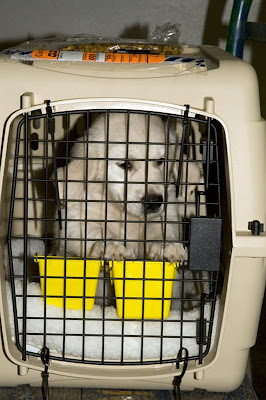PUPPY EATS 8 GOLF BALLS
Dog Undergoes Surgery To Remove Golf Balls
TheBostonChannel.com.
TheBostonChannel.com.
 X-ray of Wally's belly - yes, those are golf balls!
X-ray of Wally's belly - yes, those are golf balls!BOXBORO, Mass. -- An 8-month-old puppy is recovering from surgery after eating eight golf balls. Wally's owners said the Rottweiler pup started acting weird last week. He eventually threw up three golf balls, including one that was wrapped in a sock.
But when the dog still was acting strange, Wally's owners took him to the Boxboro Animal Clinic. "Lo and behold, there was another five golf balls sitting in there," Veterinarian Stewart Bleck said. Wally underwent surgery to have the other five balls removed.
Wally's owner Julianne Bonfilio said some friends like to putt around golf balls at their home, but they never noticed that the balls were disappearing. Bleck estimated that the balls had been in the dog's system for about a week.
'He hunts them down like truffles,' says owner
Scottish Press Association
A dog had to have 13 golf balls removed from his stomach after eating them on walks near a golf course. Oscar, a five-year-old black Labrador, was taken to the vet after his owner noticed a rattling noise coming from his pet.
The vet, Bob Hesketh, was stunned: "When I went into his stomach I was expecting one or two balls, but they just kept coming." One of the balls had been in Oscar's stomach so long, it had turned black. Oscar's owner, Chris Morrison, takes the dog for regular walks near Pitreavie golf course in Dunfermline, Fife. Oscar is thought to have swallowed the balls over a period of months.
Morrison said: "He normally picks up golf balls and brings them home but must have been swallowing some all along. I take him out early in the morning and late at night, normally around the areas of the ninth and 12th fairways. "He hunts them down like truffles. He finds them in all sorts of places where golfers lose them."
Oscar has recovered from his operation and is said to be in good health. His food is being watered down to help repair his digestive system and he is wearing a muzzle during walks to break his habit. Chris said: "He does get a bit frustrated now and again. He couldn't go running around straight away but he is now off the lead again."
DOG EATS 28 GOLF BALLS - AND SURVIVES
Nick Towle
Sout Manchester Reporter
April 26, 2004
 WHEN German shepherd Libby went off her food her owners were at a loss. The 18-month-old pup had begun losing weight and coughing up blood. Owner Mike Wardrop, a Man United reserve player in the 1970s, knew something was seriously wrong. Just how wrong was not clear until he took Libby to the vets and discovered the real reason - she'd swallowed 28 golf balls.
WHEN German shepherd Libby went off her food her owners were at a loss. The 18-month-old pup had begun losing weight and coughing up blood. Owner Mike Wardrop, a Man United reserve player in the 1970s, knew something was seriously wrong. Just how wrong was not clear until he took Libby to the vets and discovered the real reason - she'd swallowed 28 golf balls.Mike, 47, said: "I was absolutely gobsmacked when the vets said they had found 28. "To see all those golf balls at once was a staggering sight and they weighed over six pounds, so it was no wonder Libby wasn't feeling well. "The vets gave every ball back to me - they were slightly discoloured but otherwise in great condition, and they will be great for practice although I was upset to see there were no ProV1s amongst them!"
John Ford, a partner at the Greenbank Veterinary Clinic, said: "It was unbelievable. Never in my entire career have I seen anything even approaching 28 golf balls in an animal's stomach. "We didn't even need to x-ray her when she was brought in - she was clanking and we could feel them in her stomach. They could have been in there for several weeks." As Libby underwent a two-and-half operation to remove the golf balls, vets placed bets as to how many golf balls they would find. "The highest bet was 11 by Caroline Merry, the vet who carried out the operation, but she just kept finding more and more," said Mr Ford. "It's not unusual for dogs to eat stones and glass, but God knows what made the dog think the golf balls were a tasty morsel. Thankfully she came through the operation well and has made a good recovery."
Libby has to go back to the vets next week to have 38 stitches taken out and is still feeling a little ruff. She had been gulping the balls while her owner Mike, 47, took her for walks near the practice greens at Didsbury Golf Club, where he lives and works as the house manager.
Mike and wife Julie, 45, are now trying to steer Libby away from her favourite snack by changing her walking route and keeping her off the practise greens. Mike added: "Libby is a great guard dog as well as a family pet and is now running around again like her old self. Like any young dog, she likes playing with balls and I have often seen her with several in her mouth at a time, although I didn't think she was swallowing them!"


















